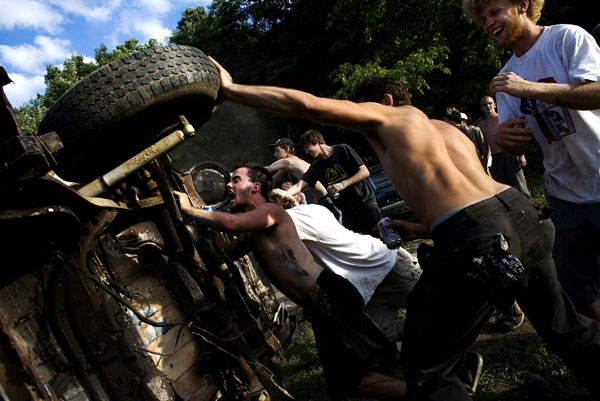Millenáris Fogadó,until 19th October
10:00 - 20:00
1800 HUF/adult; 840 HUF/student
Fény utca 20-22 [map] Buda, II, Moszkva tér (M2), 5 min
If you’ve been in Budapest for too long and yearn to travel around the world but only have a Sunday afternoon and a thousand or so forint to spare, fear not: World Press Photo 08 to the rescue.
The organization puts together the world’s most prestigious and well-traveled contest (the exhibition gets around to almost 50 countries) for excellence in photojournalism. The diverse pool of jurors is made up of experienced photographers and industry specialists from around the globe, which is reflected in the content of the show.There are plenty of truly astonishing photographs: Brent Stirton’s murdered gorilla in the Congo looks a lot like a film still from 1995's, Congo, a credit to them both. Clark Detrick’s shot of an eye-gouging on the court of a college basketball game is both lucky and stomach-churning, while Vanessa Winship’s black and white portraits of Turkish school girls hark back to the work of Diane Arbus. Chuck Close, a well known American artist, although not for his photography, contributes a welcome diversion in his daguerreotype portrait of current civil rights silhouette artist, Kara Walker, (work that one out.) Meanwhile, Yonathan Weitzman’s depiction of an African girl’s dress caught on barbed wire at the Israel/Egypt border will have you staring for more than a few seconds.
 Hungarian photographers also stand out. Balazs Gardi took first prize in the General News category for his black and white shots covering the US and Afghan army in Afghanistan. Closer to home, Zsolt Szigetváry’s poignant shot of an injured gay couple at a parade in Budapest brings Hungary's own problems into the foreground.
Hungarian photographers also stand out. Balazs Gardi took first prize in the General News category for his black and white shots covering the US and Afghan army in Afghanistan. Closer to home, Zsolt Szigetváry’s poignant shot of an injured gay couple at a parade in Budapest brings Hungary's own problems into the foreground.It is not necessarily the composition or the quality of the photography that earns a photograph high marks on World Press Photo’s list. Take John Moore’s first prize work in Spot News. His most important shots were extremely blurry, a result of his first-hand presence at the assassination - by way of suicide bombing - of Pakistani Prime Minister, Benazir Bhutto. The fact that he was able to make any photographs amidst the frenzy of the explosion makes for an incredible story.
This excellent exhibition is, however, not without its shortcomings. The building at Millenáris looks more like a warehouse or garage, with its gritty, untreated cement floors, making it feel like you’re looking at prestigious photographs while getting your car's oil changed. Many of the photos also seem to be of poor print quality (i.e., grainy, pixilated), though you may feel this is only a minor detraction. The inclusion of some of the photos certainly pushes the limits of photojournalism: Travis Dove’s shots of famed US skateboarding anarchy haven, Skatopia, for example. The photographs suggest that the presence of a photographer wasn't exactly passive, which might not fit too well with photojournalism’s code of ethics.
The inclusion of some of the photos certainly pushes the limits of photojournalism: Travis Dove’s shots of famed US skateboarding anarchy haven, Skatopia, for example. The photographs suggest that the presence of a photographer wasn't exactly passive, which might not fit too well with photojournalism’s code of ethics.Nevertheless, it would take much more than a slightly dubious series of photos to detract from the wide ranging and superb content that is displayed in the majority of the exhibition.
Jacob P.
0 Comments:
Subscribe to:
Post Comments (Atom)

